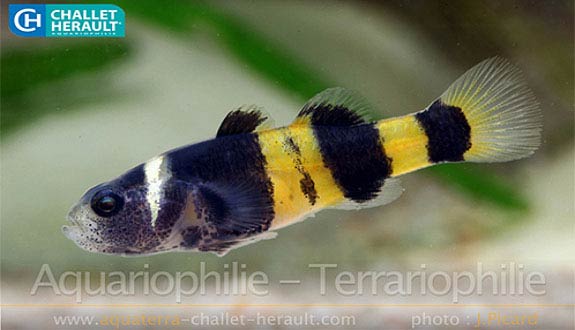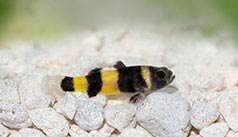

Alternative species (click on the thumbnail to see the card)
Names
Scientific name
Brachygobius xanthozonus
Brachygobius xanthozona
Gobius xanthozonus
Gobius xanthozona
Common name
Bumblebee fish
Origin

Origin: Indonesia, Sumatra, Borneo, Thailand
Biotope: Asian
Dimorphism

The male has more contrasting colors than the female.
Group

Gobiidae
Volume

60 L / 13 imp gal / 16 US gal
Parameters

T°: 22 to 28°C or 72 to 82°F
pH: 7.5 to 8.5
Hardness: 20 to 35°dGH
Difficulty

Hard
Size

3 to 5cm (1.2 to 2")
Longevity

2 to 4 years
Living zone

Depth
Individuals

6
Food
How to feed the Bumblebee fish?
Food
How to feed the Bumblebee fish?
Brachygobius xanthozonus is a carnivorous fish. It accepts frozen food but will have a preference for live prey such as bloodworms, daphnia or artemia.
It should be noted that this fish does not like dry food (such as flakes or flakes) sold commercially, and many specimens never accept it.
Behavior
What kind of behavior does the Bumblebee fish have?
Behavior
What kind of behavior does the Bumblebee fish have?
This fish spends most of its time at the bottom of the aquarium, resting on its pelvic fins (fins located under the belly). At night, it comes out more easily because it tends to be nocturnal.
Territorial tensions may appear between males. Little tip: to limit friction, plan areas delimited by pebbles, roots or plants. This will make it easier for males to isolate themselves visually from each other. The formation of a group of at least 6 individuals is essential to dissipate tensions and satisfy the gregarious instinct of the species. Your group will have more females than males.
Cohabitation
Who can live with the Bumblebee fish?
Cohabitation
Who can live with the Bumblebee fish?
The bee fish is a peaceful fish that is not aggressive with other species. However, a specific aquarium is preferable for the maintenance of this species. Firstly because of the desirable water parameters (brackish water) which is not suitable for many species. In addition, its nocturnal activity may disturb the other occupants of your aquarium. In addition, some aquarists have reported cases of fin bites during the night.
Breeding
How to breed the Bumblebee fish?
Breeding
How to breed the Bumblebee fish?
The difference between male and female is very difficult. Generally speaking, the male has slightly more contrasting colours and the female has a more rounded abdomen (especially during the breeding season).
Breeding of Brachygobius xanthozonus is rare and difficult.
Provide an egg-laying tray of about 20 litres (4 Imp Gal or 5 US Gal) with cavities (natural stone arrangement, small inverted flower pots, shells, ceramic tubes, etc.). High salinity is also important to simulate their natural habitat (take water from the main aquarium which should normally be brackish). Filter on activated carbon.
Introduce the selected couple. Within a few days, eggs will appear in the cavity (between 100 and 150 eggs). The male takes care of the eggs while the female returns to her occupation (you can remove her from the laying tank). Incubation of the eggs lasts between 4 and 6 days depending on the temperature. As soon as the fry swim freely, the male leaves the fry which are now autonomous. You can then remove him too from the rearing aquarium.
Food for the fry: cyclops, artemia nauplia.
Its aquarium
Which aquarium for the Bumblebee fish?
Its aquarium
Which aquarium for the Bumblebee fish?
A specific aquarium allows each specimen to have for a territory that satisfies him. It is the maintenance most adapted to this species.
For better health and maximum comfort, a slightly brackish water is desirable. Indeed, this corresponds to the natural living conditions of this fish. To do this, dilute 2 grams of sea salt per litre of water. You can also make the fresh water/salt water mixture with a proportion of 1/4 seawater.
Provide plenty of plants and elements to visually separate territories. It is always best to anticipate this kind of need and take it into account when designing your aquarium, well before the fish arrive!
For the floor, choose sand that you will scatter with pebbles.
Good To know
Find all additional information!
Good To know
Find all additional information!
Brachygobius xanthozonus has beautiful colours, its name bee fish comes from its bee-like colouring pattern. Furthermore, its name "xanthozonus" comes from Latin and means "with yellow stripes".
Beware of confusion with Brachygobius doriae, a species with which it has been confused for decades. B.xanthozonus has more than 50 lateral scales, compared to only 30 in B.doriae, which gives it a more elongated appearance. Finally, the species presented in this sheet is very rare in the aquarium trade and it is unlikely that you will find a true xanthozonus (not generally part of the hobby aquarium trade).
The Brachygobius type nowadays includes 9 described species:
- Brachygobius aggregatus
- Brachygobius doriae
- Brachygobius kabiliensis
- Brachygobius mekongensis
- Brachygobius nunus
- Brachygobius sabanus
- Brachygobius sua
- Brachygobius xanthomelas
- Brachygobius xanthozonus
All are known as "bumblebee gobies" but only B.doriae and B.sabanus are commonly available commercially.
Yours photos!
Comments
Sort by:
Please login to post comments


